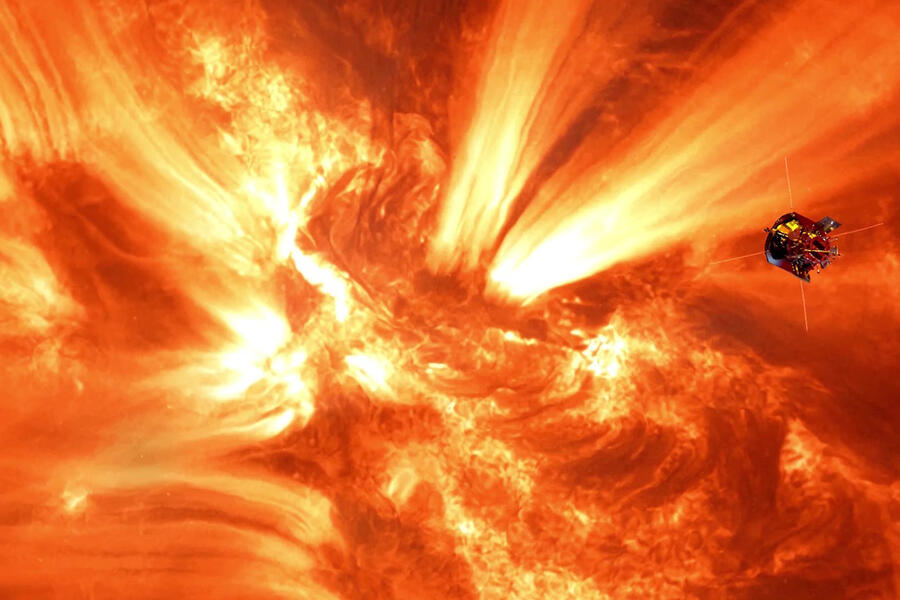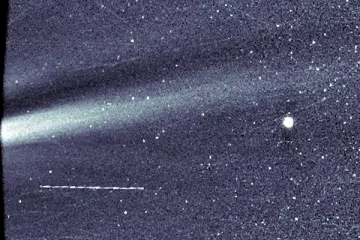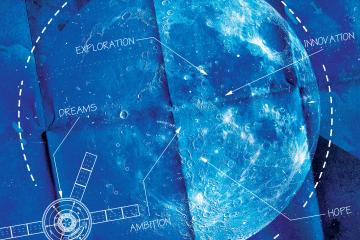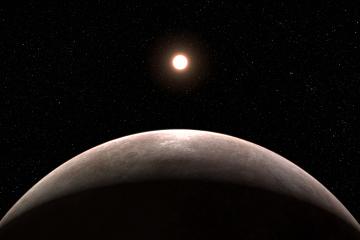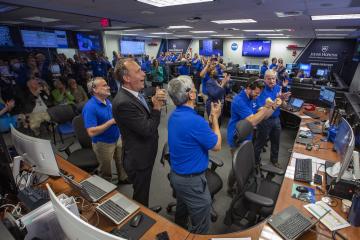NASA's mission to "touch" the sun has confirmed that it survived its record-breaking closest approach to the sun's surface on Dec. 24.
Breaking its previous record by flying just 3.8 million miles (around 6.1 million kilometers) above the surface of the sun, NASA's Parker Solar Probe hurtled through the solar atmosphere at a blazing 430,000 miles per hour (692,000 kilometers per hour)—faster than any human-made object has ever moved. A beacon tone, received in the mission operations center at the Johns Hopkins Applied Physics Laboratory (APL) late on Dec. 26, confirmed the spacecraft had made it through the encounter safely and is operating normally. APL designed, built, and operates the spacecraft from its campus in Laurel, Maryland.
This pass, the first of more to come at this distance, is allowing the spacecraft to conduct unrivaled scientific measurements with the potential to change our understanding of the sun.
Video credit: NASA
"Getting this close to the sun is a historic moment in our quest to uncover the mysteries of our nearest star," said Nicky Fox, associate administrator for NASA's Science Mission Directorate. "By studying the sun up close, we can better understand its impacts throughout our solar system, including on the technology we use daily on Earth, as well as learn about the workings of stars across the universe."
"This accomplishment is a testament to the dedication and innovative spirit of the entire Parker Solar Probe team," said APL Director Ralph Semmel. "Their incredible technological breakthroughs enabled this amazing mission, and they have delivered critical new insights that are revolutionizing our understanding of heliophysics and space weather."
Parker Solar Probe has spent the last six years setting up for this moment. Launched in 2018, the spacecraft used seven flybys of Venus to gravitationally direct it ever closer to the sun. With the last Venus flyby on Nov. 6, the spacecraft reached its optimal orbit, an oval-shaped loop that brings it around the sun every three months—close enough to study our sun's mysterious processes but not too close to become overwhelmed by the sun's heat and damaging radiation. The spacecraft will remain in this orbit for the remainder of its primary mission and potentially for many years after that.
"Parker Solar Probe is braving one of the most extreme environments in space and exceeding all expectations," said Nour Rawafi, project scientist for Parker Solar Probe at APL. "This mission is ushering in a new golden era of space exploration, bringing us closer than ever to unlocking the sun's deepest and most enduring mysteries."
Close to the sun, the spacecraft relies on a carbon foam shield to protect itself from the intense heat. The shield was designed to reach temperatures of 2,600 degrees Fahrenheit (around 1,430 degrees Celsius)—hot enough to melt steel—while keeping the instruments behind it shaded at a comfortable room temperature. Spacecraft operators expect the shield to have faced temperatures around 1,800°F (980°C) at closest approach.
"It's monumental to be able to get a spacecraft this close to the sun," said John Wirzburger, Parker Solar Probe mission systems engineer at APL. "This is a challenge the space science community has wanted to tackle since 1958, and it spent decades advancing the technology to make it possible."
By flying through the solar corona, Parker Solar Probe can take measurements that help scientists better understand how the region gets so hot, trace the origin of the solar wind (a constant flow of material escaping the sun), and discover how energetic particles are accelerated to half the speed of light.
"The data is so important for the science community because it gives us another vantage point," said Kelly Korreck, a program scientist at NASA Headquarters and heliophysicist who worked on one of the mission's instruments. "By getting firsthand accounts of what's happening in the solar atmosphere, Parker Solar Probe has revolutionized our understanding of the sun."
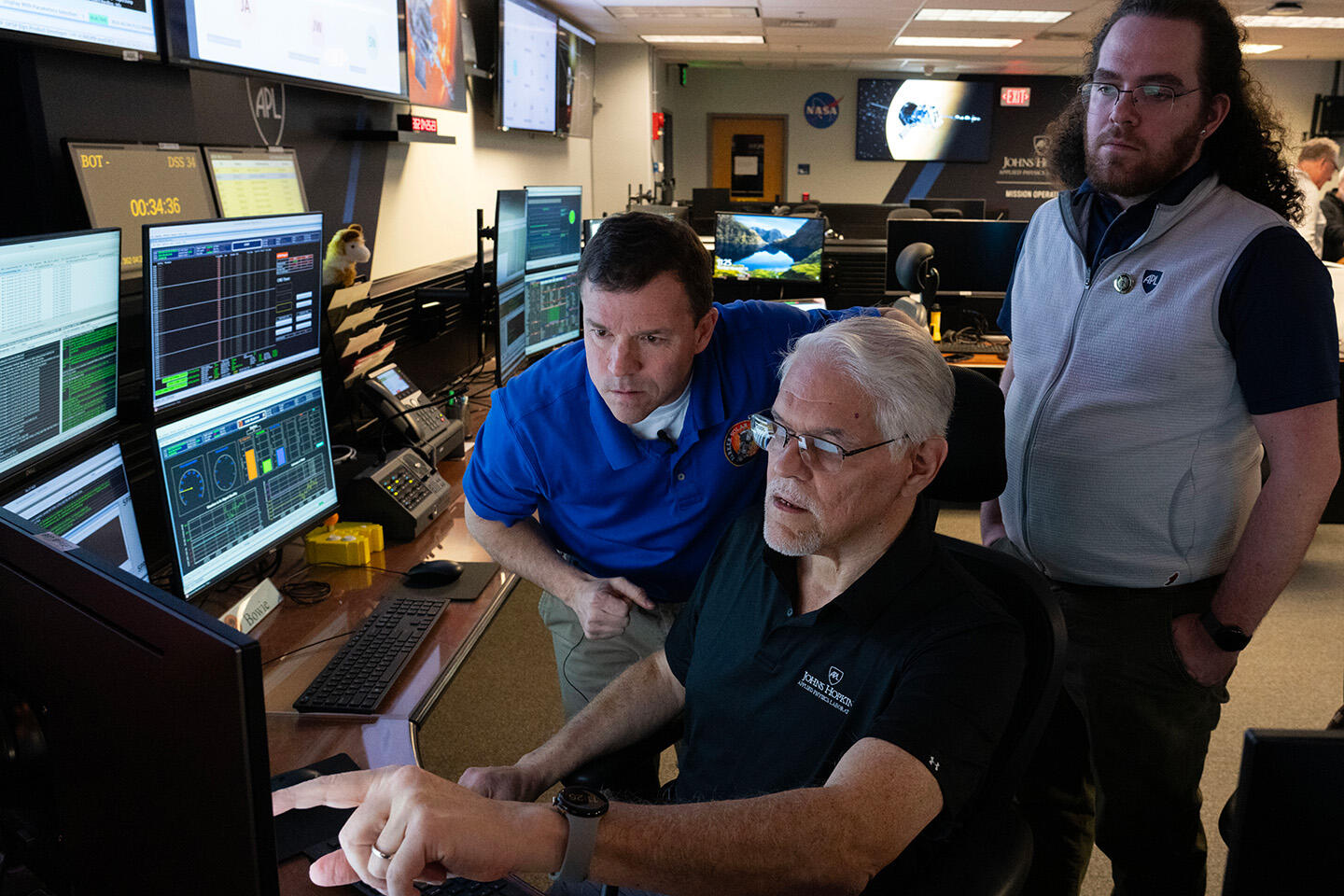
Image caption: In the Parker Solar Probe mission operations center at the Johns Hopkins Applied Physics Laboratory (APL) in Laurel, Maryland, from left, Nick Pinkine, Eliud Bonilla, and Nate Arbor await a signal from Parker Solar Probe indicating its status following its record-breaking flight on Dec. 24, 2024, just 3.8 million miles (around 6.1 million kilometers) from the Sun’s surface. The team confirmed receipt of the signal, indicating Parker was healthy and operating normally, late on Dec. 26, 2024.
Image credit: NASA / Johns Hopkins APL / Steve Smith
Parker's 21 previous passes have already resulted in scientists getting insights into the inner working of the sun. The magnetic field zig-zag-shaped structures, called switchbacks, observed by Parker Solar Probe in abundance close to the sun hold key insight into the plasma heating and acceleration. Since April 2021, the spacecraft has been spending more time flying through the immediate solar atmosphere—the corona—where most of the critical physical processes occur.
"We now understand the solar wind and its acceleration away from the sun," said Adam Szabo, Parker Solar Probe mission scientist at NASA's Goddard Space Flight Center in Greenbelt, Maryland. "This close approach will give us more data to understand how it's accelerated closer in."
By flying through the colossal coronal mass ejections close to the sun, Parker Solar Probe has also made numerous discoveries, showing in particular the effect of the structures on their surrounding environment. Observations showed how these giant solar explosions sweep everything in their way, leaving a near-perfect vacuum behind. Parker Solar Probe measurements through the narrow shock waves driven by coronal mass ejections are yielding unprecedented discoveries about the energization of hazardous solar energetic particles.
Flybys of Venus led to the discovery of the shortest wavelength thermal emission from the surface of the planet, opening a new window to study the Venusian terrain. Other observations have shown the first complete image of its orbital dust ring.
So far, the spacecraft has only transmitted that it's safe, but soon it will be in a location that will allow it to downlink the data it collected on this latest solar pass.
"The data that will come down from the spacecraft will be fresh information about a place that we, as humanity, have never been," said Joe Westlake, the director of the Heliophysics Division at NASA Headquarters. "It's an amazing accomplishment."
The spacecraft's next planned close solar passes come on March 22, 2025, and June 19, 2025.
Parker Solar Probe was developed as a part of NASA's Living With a Star program to explore aspects of the sun-Earth system that directly affect life and society. The Living With a Star program is managed by the agency's Goddard Space Flight Center in Greenbelt, Maryland, for NASA's Science Mission Directorate in Washington. APL manages Parker Solar Probe for NASA and designed, built, and operates the mission.
Posted in Science+Technology




